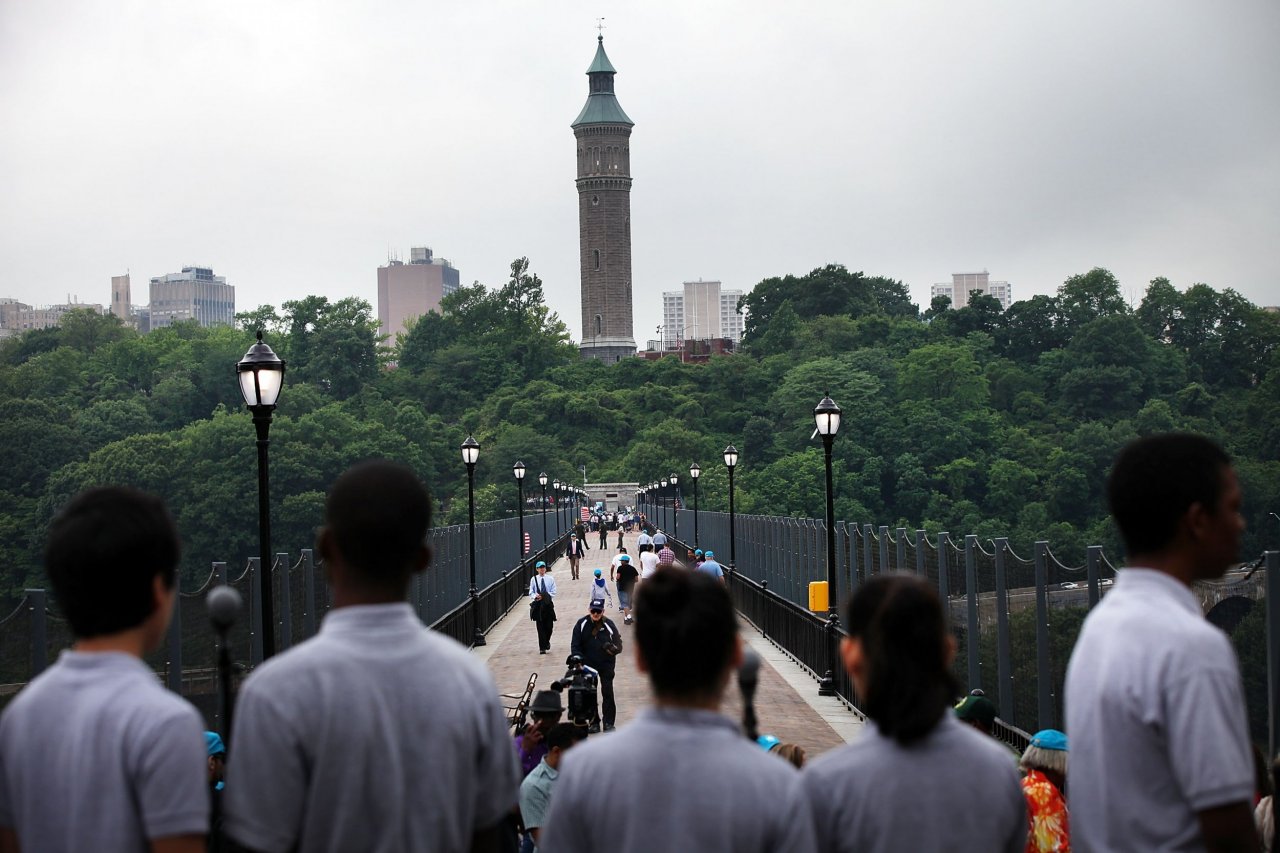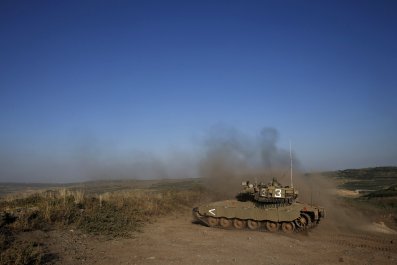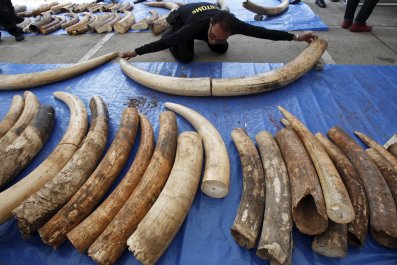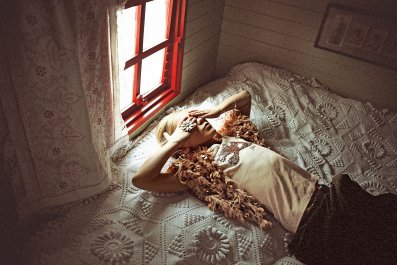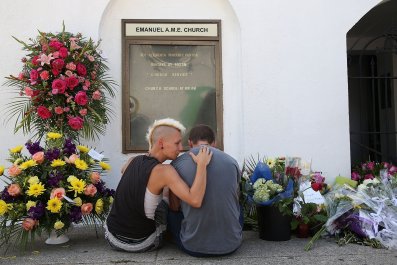Once branded the worst slum in America, Charlotte Street today looks suspiciously like suburban Connecticut. Let the record show that this South Bronx strip bears no resemblance to the post-nuclear wasteland visited by President Jimmy Carter in 1977, when it earned its infamous distinction. Nor the one that, three years later, Ronald Reagan compared to London during the Blitz, except that no Luftwaffe had come to flatten the Bronx. This was not a battle but an implosion. Everyone was a victim or a captor. If there were conquerors, they were of the furtive sort, hoisting no flags.
By the time Bill Clinton visited Charlotte Street in 1997, the mood was no longer funereal. Charlotte Street had been reconstructed into a stretch of single-story houses, despair giving way to vinyl siding. "I would like every single American to see the before and after," Clinton said. President Barack Obama has been to the Bronx, but not to Charlotte Street, for it had been tilled fully for political significance by the time he assumed office. Once the site of extraordinary ruination, then of extraordinary renewal, Charlotte Street is today an ordinary place.
On a crushingly humid afternoon this past spring, I drove along Charlotte Street with Lloyd Ultan, the Bronx borough historian, and Shelley Olson, a composer who moved to the Bronx from the Upper West Side several years ago. Ultan and Olson have co-authored The Bronx: The Ultimate Guide to New York City's Beautiful Borough, which they bill as the first enchiridion for the much-maligned borough. Their idea is a novel one: People want to learn about the Bronx, to walk its streets and taste its delicacies. People are no longer afraid.
I spent a day driving through the borough with the enthusiastic duo, in what proved a tour but also an extended sales pitch meant, I came to strongly suspect, to erode my longstanding allegiance to Brooklyn. Did I know that the Bronx has more parkland than all the other boroughs? Or that the Grand Concourse is the nation's largest preserve of Art Deco and Art Moderne apartment buildings? Had I tasted my way along Arthur Avenue, New York's last true Little Italy? Was I ready for the riparian secrets of City Island, the sylvan mysteries of Spuyten Duyvil? Was I ready to look at some real estate?
Their book is part of a greater effort to restore the image of the Bronx, to finally expunge the ghosts of '77, when Howard Cosell announced to the entire world that the Bronx was burning. It was only a single building aflame, but, well, details. There were other indignities, too: Fort Apache: The Bronx (1981), a lurid tall-tale of Bronx cops defending Western civilization against dark-skinned interlopers; The Bonfire of the Vanities (1987), in which an errant foray into the Bronx topples a Master of the Universe.
But the Bronx bogeyman is not so frightening anymore. At the very least, he's learning how to monetize his famous street cred. In February, Baz Luhrmann announced that he is directing a Netflix series called The Get Down, which will follow "the lives and music of a ragtag crew of South Bronx teens." Luhrmann has already promised that he won't merely focus on images of decay. "At a certain point," he said recently, "rubble is just boring."
Cultural image often smooths the road to reality, gentrifying perceptions before a single building is gut-reno'd into a luxury living experience. Seinfeld made its premiere in 1989, when three times as many people were murdered in New York City as in 2014. And yet the show made Manhattan seem like a skyscraper shtetl peopled by charmingly neurotic Jews. You could probably see your kid living there. You could definitely see your kid living in the Greenwich Village of Friends (b. 1994), which assured millions of Americans each Thursday night that if Rachel and Chandler could make it in the big city, so could the restless young men and women of Peoria. Sex and the City (b. 1998) was the coup de grâce: The city was not just safe, but fabulous. Shall we have another round of cosmos?
Brooklyn's cultural gentrification has been even more impressive, given how little the borough mattered before suddenly coming to matter more than its slender sibling across the East River. Between the clothing of Brooklyn Industries, the music of Williamsburg bands like the Yeah Yeah Yeahs and the brownstone novels of Jonathan Lethem, there congealed an image of the borough as the city's Quartier Latin, at once edgier and cozier than Manhattan. With the advent of Girls, even your weird uncle in Palookaville could pontificate on how lame Bedford Avenue has become.
Also in March came Arlene Alda's Just Kids from the Bronx, a collection of oral histories by some of the borough's most famous progeny: Colin Powell earning a quarter at a Hunts Point synagogue for flipping the lights during Shabbat; Mary Higgins Clark coming of age down the block from Jake "Raging Bull" LaMotta. Alda writes that she was encouraged in her effort by the jewelry designer Joel Arthur Rosenthal. "I'm glad that you're doing a book about the Bronx," he confided in her. "I'm sick and tired of hearing about Brooklyn."
It occurred to me that I'd just heard the exact same sentiment somewhere else: in Anthony Bourdain's CNN documentary series Parts Unknown, the fourth season of which alighted on the Bronx, along with exotic foodie destinations such as Paraguay, Tanzania and Massachusetts. "You've been to Brooklyn," the culinary explorer declares. "Maybe it's time you took a look at the Bronx."
"Boys Stone Boat, Hurt Sight-Seers," read a New York Times headline on April 21, 1958. According to the brief article, "a gang of juveniles" had stood on the pedestrian walkway of the High Bridge, which connects upper Manhattan to the Bronx. They threw "sticks, stones, and large pieces of brick" down onto a Circle Line cruise ship passing on the Harlem River below. Four tourists were injured, including a 12-year-old girl.
Throwing things from the High Bridge became a popular pastime, and the span closed to pedestrians sometime in the ensuing years. The city's oldest bridge, it had originally been part of the Croton Aqueduct, which supplied the city with drinking water. By the latter decades of the 20th century, though, the High Bridge had become an apt symbol for the rest of the borough, abandoned and unloved. Navigating the tangle of highways leading out of the Bronx, you might have taken it for a vestige of better days before it disappeared in your rear-view mirror, along with the rest of the God-forsaken borough.
On a recent June morning, I watched as two competing factions walked from opposing sides of the bridge and met in the middle of the span, beneath a low and violent sky. A crowd quickly congealed around the groups; many police officers were also on hand. But this wasn't a scene out of The Warriors. The two rival groups were political delegations from the Bronx and Manhattan, and they met to celebrate the reopening of the High Bridge, after a refurbishment of nearly $62 million.
Despite the incipient rainfall, a festive mood prevailed. A choir of school children sang African songs, while city workers passed out free hats. Selfies abounded, capturing river vistas long unseen. As far as infrastructure is concerned, the High Bridge's return is nothing much, but the psychological significance is great. There are more than a dozen bridges between Manhattan and the Bronx, yet they are all primarily for cars or trains moving through the borough, not into it. High Bridge is the only one that is explicitly for the residents of the central Bronx and upper Manhattan: it connects only them, offering nothing to those seeking passage to Westchester or Connecticut. It is a crucial rivet patched up and polished, made to gleam anew.
Brooklyn may define itself as the anti-Manhattan, where old timers in Bensonhurst still bemoan the "Great Mistake of '98" (i.e., the city's unification 117 years ago) and Park Slope graphic designers brag about how rarely they venture into "the city." But the Bronx is proud of its affiliation to the mother ship. "Of all the places in Manhattan's general orbit, the Bronx is (and this is its enduring strangeness) both the poorest and the least alienated. That every other place is more distinguishable is true in part because every other place has taken greater pains to contrast itself with Manhattan," writes New York magazine's Ben Wallace-Wells in a graceful pean to his home borough, noting that "the blessing of proximity to Manhattan is that things conceived in the Bronx can quickly take off."
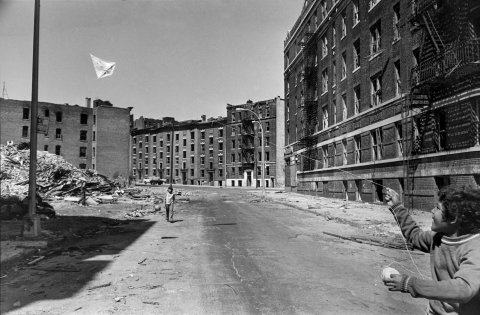
It is also true, however, that things can take longer to take off in the Bronx than elsewhere. The High Bridge stood in disrepair for four decades. The Kingsbridge Armory, the largest structure of its kind in the entire world, has also languished in bureaucratic limbo. Sometime in the future, it is set to become a National Ice Center, a strange and underwhelming choice for a borough where the primary sports are basketball and baseball. And while the Loew's Theatre in the Flatbush section of Brooklyn has been gorgeously restored to its pre-war glory, the Loew's Paradise Theater on the Grand Concourse stands covered in grime and obscured with placards, serving as the church of prosperity preacher Creflo Dollar.
This is what makes the Bronx so bewildering and beguiling. Walk the borough's streets and the feel of latent possibility lodges in your nostrils like the pollen of some strange indigenous plant. On the same block, the borough may be graceful and profane, it may curse you out or bid you good afternoon. Sometimes squalid, the Bronx is rarely grim. And though never polite, the Bronx is very much alive.
No neighborhood bears more proximity to Manhattan than Mott Haven, a single subway stop into the Bronx. It is one of those places that is more talked about than visited. Once in a while, you do meet some scruffy artist who lives there, some skinny-jeaned hipster for whom Brooklyn is lame and Manhattan is death. The South Bronx is where it's at, man, haven't you heard? A crowd will inevitably gather around him at a party, as if he'd recently escaped a North Korean prison camp. Everyone wants to know his rent.
"Goodbye South Bronx Blight, Hello SoBro," declared The New York Times in 2005, in one of many articles (in that newspaper and others) proclaiming the looming coronation of the South Bronx as the next East Village, the next Williamsburg, the next Place Where Every Wesleyan Grad Will Yearn to Move. It must have been a long goodbye, because 10 years later another Times article hit pretty much the same themes: "Mott Haven, the Bronx, in Transition."
In truth, the physical terrain of Bronxlandia isn't all that much to behold: a couple of brownstone blocks on Alexander Avenue, bookended by housing projects. On the other side of the Bruckner Expressway, there is a strip of warehouses that could pass for the set of Girls, though also for the set of The Wire. There are few trees. The air feels heavy and unclean. But gentrification is happening here, and it is real: after all, how much deeper into Queens and Brooklyn can hip and moneyed newcomers push before they find themselves on Long Island?
Certainly, the Bronx is making its entreaties to the creative classes. Last year, the Bronx Brewery opened on East 136th Street, in the Port Morris section of the Bronx, not far from the hip striplet of Mott Haven. It is the borough's second brewery; there are two distilleries in the Bronx as well, leading to what The Times has called "a growing artisanal spirits movement in a borough." The borough is also home to two urban farms, and both sell their produce at a weekly Mott Haven farmers' market. There is a tech incubator, too, thus completing the holy trinity of New Urbanism.
Then again, the old adage about a rising tide lifting all boats hasn't quite come true here on the Harlem River. Two blocks away, in the Mitchel Houses, few residents can sate themselves on challah french toast at local haunt Charlie's, which looks like it has been airlifted from one of Harlem's better blocks. In 2010, this was the poorest district in the nation, according to the U.S. Census Bureau, with 38% of its population living in poverty. Childhood asthma rates are high. Education rates are low.
As I walked up Third Avenue, past a long strip of housing projects, I was struck by a strange sight: a white woman decked out in tight neon gear, jogging down the street, dodging old men with sagging bags of groceries and young women pushing strollers, her red ponytail bouncing, earbuds firmly planted in her ears. I stopped and squinted, as if a rare woodpecker had flown into my sight. Of course, if she was a preposterous sight, then so was I, Google Mapping my way through the borough, notebook in hand, like some latter-day Darwin recording the native fauna. We are part of the same invasion, radiating from the Mott Haven beachhead ever deeper into the Bronx. We are coming, and we demand brunch.
To illustrate the beauty and promise of the Bronx, Lloyd Ultan, the borough historian, likes to show a photograph from about 1890. It is an image of several men and women in front of Cedar Jack's Last Stand Clam Bar, a thriving restaurant in Melrose, not far from where Yankee Stadium stands today. Cedar Jack is at the edge of the photograph, arm on his hips, dressed in a bowler hat and vest, looking confidently into the camera. There is one remarkable thing about the photograph: Cedar Jack is black, while all his customers are white.
As far as Ultan is concerned, the photograph alludes to the "racial acceptance" that prevailed in the Bronx. He points out that during the Draft Riots of 1863, when dozens of blacks were killed in Manhattan and Brooklyn, not a single African-American lost his life to mob rule in the Bronx. In 1943, after riots in Harlem stemming from the shooting of a black man by a white police officer, blacks who had only recently escaped the South now escaped Manhattan for the Bronx. Ethnic whites in Mott Haven set up welcoming committees, Ultan says, and many local merchants made sure that the new arrivals had jobs.
That history does have its unseemly moments, as much as Ultan would like to downplay them. We stood talking in front of the John Purroy Mitchel Houses, whose red brick towers rise like the ossified stumps of enormous prehistoric trees. In 2005, the New York Police Department arrested 43 members of a drug ring that allegedly turned the housing project into what came to be known as "Crip City." Nearby are the Moore Houses, where last year 24 alleged members of the Murda Moore Gangstas were arrested.
Several days after touring the Bronx with Ultan and Olsen, I went to see the actual Fort Apache, which is the former 41st precinct building in the Longwood neighborhood. The name may have originated in the 1960s, but it became cultural shorthand with the 1981 film starring Paul Newman as a pretty good cop in a really bad place.
Locals suspected (correctly) that their borough would be depicted as a Boschian hellscape ruled by no discernible human law. They protested, hoisting signs that declared, "Fort Apache is an anti-Puerto Rican, anti-black movie" and "Paul Newman: From Liberal to Racist for $3,000,000." This anger didn't stop filming, but Fort Apache did get a disclaimer, which appears before the movie and points out that since Fort Apache is a cop flick, it "does not deal with the law abiding members of the community." With that out of the way, the ruin porn begins.
Today, Fort Apache is no longer in a war zone: The surrounding blocks have a sleepy, suburban feel, very similar to Charlotte Street, that onetime symbol of Bronx hopelessness. The young officer behind the desk didn't even know the building's legend as Fort Apache. You couldn't exactly blame him. Last year, there were only four murders in the precinct, a full 11 times fewer than there had been in 1990.
Maybe it's better that the young officer had no idea about Fort Apache, that his Bronx was not the Bronx of flattened buildings and roaming junkies. It may be true, as William Faulkner said, that the past is never past. But the present also has its say. And it says that in the Bronx, it is not 1977 anymore.



